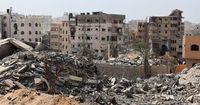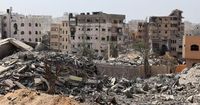On Friday, October 3, 2025, a convoy of armored vehicles rumbled through the battered streets of Gaza City, carrying with it a small group of international journalists. The Israeli military, which has tightly controlled access to Gaza for nearly two years, offered this rare and closely supervised tour as part of its ongoing campaign to root out Hamas. The visit, though brief and limited, provided a window into a city devastated by war, where the scars of conflict are etched into every shattered building and deserted street.
According to the Associated Press, the journalists' journey began along the Netzarim corridor—a heavily militarized route that now divides northern and southern Gaza. The corridor, littered with rubble and the remnants of once-bustling neighborhoods, has become a symbol of the territory's fragmentation and the immense challenges facing its residents. As the armored vehicles advanced, the silence was broken only by the distant echo of gunfire and the rumble of artillery, reminders that the fighting is far from over.
The tour's first major stop was near a hospital formerly run by the Jordanian government. The facility, which shut down about two weeks prior to the visit, stood empty and surrounded by collapsed buildings. Israeli soldiers pointed out what they described as a recently discovered tunnel, allegedly constructed and used by Hamas. According to the Israeli military, a drone video had revealed a 1.5-kilometer tunnel with explosives lining its walls, stretching beneath the hospital grounds. They claimed that while the Jordanians operated the hospital above ground, Hamas was manufacturing weapons in a room below.
However, as reported by the Associated Press, a Jordanian official, speaking anonymously, denied that the hospital had ever been used by Hamas for military purposes. The AP also noted that it could not independently verify the Israeli army's claims, highlighting the ongoing challenges of obtaining reliable information in a conflict zone where access for independent verification remains tightly restricted.
The tour continued through Gaza City's Sabra neighborhood, where the devastation was even more apparent. Soldiers with Israel's 36th division were stationed in a house they said had been previously used by Hamas. Inside, the floors were blanketed with shards of glass and concrete, wires dangled from the ceiling, and handwritten instructions in Hebrew decorated the walls—a stark reminder of the building's new occupants. Journalists were cautioned to avoid standing near windows; a soldier explained that sniper fire had struck the neighboring building just a day earlier.
Throughout the drive, few signs of life were visible. Most of Gaza City's once-vibrant population—estimated at around one million before the war—has either fled or been displaced. According to the United Nations and the World Health Organization, hundreds of thousands were forced to leave under Israeli evacuation orders at the outset of the conflict, but many returned during a ceasefire earlier in 2025. The AP reported that, before the latest offensive began in September, Israel issued fresh warnings for civilians to move south, with Defense Minister Israel Katz declaring on October 1, 2025, that anyone remaining would be considered a Hamas supporter.
Yet, as one senior Israeli army official told journalists during the tour, the reality on the ground is more complex. "We're trying every day to explain how much safer it is to go down to the south," the official said. "And when we get closer to areas with a lot of population, we stop and we try with other means to get them out of this area." Many Palestinians have remained in Gaza City, some unable to afford the journey south, others too weak or unwilling to leave their homes behind yet again.
The humanitarian situation in Gaza is dire. Of the territory's 36 hospitals, only 14 remain partially operational, according to the World Health Organization. The rest have either been destroyed or forced to close due to ongoing attacks and a lack of resources. International experts declared the city to be in famine as recently as August, warning that the Israeli offensive and mass displacement were exacerbating an already critical crisis. Israeli officials have accused Hamas of using hospitals and other civilian infrastructure as cover for military activities, but, as noted by the Associated Press, evidence for these claims remains limited. Hamas security personnel have reportedly been seen in hospitals, and some areas have been kept inaccessible, further complicating efforts to assess the situation independently.
The origins of the current conflict trace back to October 7, 2023, when Hamas launched a surprise attack on Israel, killing approximately 1,200 people and abducting 251 others. Israel responded with a massive military offensive, which has since claimed the lives of more than 67,000 Palestinians, according to Gaza's Health Ministry. The ministry, part of the Hamas-run government, reports that women and children make up about half of the dead—a figure considered by the U.N. and many independent experts to be the most reliable estimate available, despite the challenges of wartime reporting.
As the war drags on, the Israeli military's stated aim is to eliminate the remaining Hamas strongholds while minimizing civilian casualties. But the devastation in Gaza City tells a story of immense human suffering. Entire neighborhoods have been reduced to rubble, and the daily struggle for survival has become the new normal for those who remain. Access to basic necessities—food, water, medical care—has become increasingly scarce, and the psychological toll of living under constant threat is profound.
Amidst this backdrop, there are signs that a diplomatic solution may be on the horizon. Preparations are underway for a U.S.-brokered ceasefire plan proposed by President Donald Trump. According to Israeli officials, the army is preparing to shift from an offensive to a defensive posture after Hamas indicated it had accepted parts of the deal, though some elements still require negotiation. The first phase of the plan is expected to focus on ending hostilities and securing the release of the remaining 48 hostages held by Hamas.
Still, uncertainty hangs over Gaza City. On Saturday, the Israeli army warned Palestinians elsewhere in Gaza not to return to the city, calling it a "dangerous combat zone." For the tens of thousands who have lost family members, homes, and livelihoods, the prospect of peace remains elusive, overshadowed by the daily realities of war.
The journalists' tightly controlled tour may have lasted only a few hours, but it offered a stark glimpse into the ongoing tragedy in Gaza City—a place where the line between civilian and combatant is blurred, and where the hope for a normal life seems, for now, heartbreakingly out of reach.


